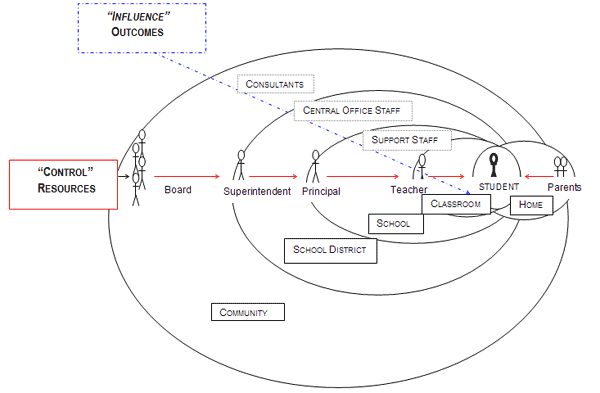New Understanding: Decision-making relationships
Decisions often are considered evidence of “power” based upon the cause-effect assumption that control of means determines ends. With this lens, however, it’s possible to differentiate between Power over… and Power to…
- Arrayed on the horizontal “Control Resources” line are those who, through their decisions, “control,” and are accountable for, the resources that are the “inputs” to the system’s decisions.
You also can see the overlapping nature of what people usually are held individually accountable for and (as we shall see) raise different questions about how that can be possible. And, if not, what then they can be accountable for.
- On the diagonal “Influence Outcomes” line are those whose organizational roles can only influence the system’s “outcomes.” They have a Power to….influence results, but not Power over…the decisions that create those results. This means they can’t make a difference for children except by first being accountable for making a difference for those whose role is to continually solve problems and make decisions on the horizontal line.
Together, it becomes possible to think about how to collaboratively share responsibility for outcomes by functionally aligning and connecting individual accountabilities.
QUESTIONS TO THINK ABOUT:
- “Structure in living systems means the basic interrelationships that control behavior. …In human systems, structure includes how people make decisions – the “operating policies” whereby we translate perceptions, goals, rules and norms into actions.”‘ Peter M. Senge, The Fifth Discipline.
How does this perspective help understand the current structure of functional and dysfunctional interrelationships that influence what people make decisions about, and how they make them?
- The daily work of those whose jobs on the horizontal line require them to make responsible decisions about resources, must have at the same time a response-ability to continually solve the problems of responding to the present needs and requirements of those in their “circles of accountability.” What information and support must they have from those on the diagonal line who share responsibility for the results of that problem-solving process?
- Understanding that everyone in the “system” has a mind pre-wired to learn from interaction, it becomes a little easier to see how the system has the potential to influence those that manage the immediate environment within which that mind at its center interacts and learns. And where the opportunities to create and support that interaction may be.
- Using the lens to understand the yin/yang of accountability/responsibility, note that accountability for the individual focuses on internal effectiveness – their control over their own behavior. What they do with what they have. For the system, accountability focuses on the processes that enable its parts to do that as part of the work of achieving the outcomes they are mutually responsible for.
- If the shared common drive of those on the horizontal line is to make a difference for students …and know it, what information do they need that helps them understand the direct differences they make on the others who also directly make a difference for children? How can this information be generated and fedback as part of work?
- Think about most current efforts to develop “accountability systems.” They seem to be based on a forensic approach that analyzes the end products of events to produce information that can help understand what and why they are as they are. As the popularity of the CSI TV series suggests, it seems like a rational approach to problem-solving when you don’t understand or have access to the “causes” of the “effects” being measured.
But there seems to be a flaw in that rationality. And it’s caused by the yin/yang nature of the “means/end” relationship. While its obvious that the results being measured and then used by most accountability systems have causes, the prevailing assumption in schooling is that the “means” to the student learning “ends” is an individual practitioner who then can be rewarded, punished, or “fixed.”
Where this logic fails is when the ends/results are the product of the decisions of more than that individual at the end of the process.
And in schooling, they are the product, not sum, of the system’s core work processes.
WHERE ANSWERS TO THESE QUESTIONS CAN BE FOUND IN MCPS:
The idea of “shared accountability” had been planted during the priority setting of the Call to Action, and the growing comfort working in processes with others who, in effect, “shared responsibility” for the district’s overall results has framed and supported a way of thinking that has enabled them to rethink the ways they gather, anayze, store and exchange “data” and experiential information.
The story of this development, as recently been documented by the Gates/Stupski foundations, noted that:
“Accountability at MCPS has evolved into a web of interconnected systems designed to support high quality instruction and student outcomes. It has done this by creating a sense of shared responsibility for high expectations, clear targets and professional standards. It has been supported through creating effective interactions between all stakeholder groups. It has defined the roles, tools and strategies needed to organize the improvement process and to manage the data flow.”
See also, Rhodes, Lenses and Gauges, 11/20/2000; and Information Management in the System of Shared Accountability-Responsibility, May 2001

